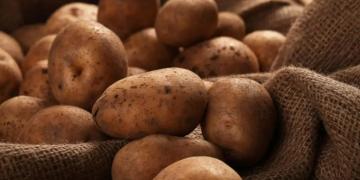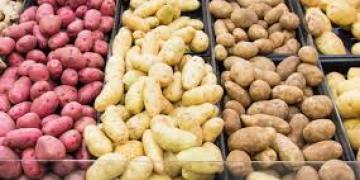EEUU: CPAC: Strong potato prices could be eaten up by war in Ukraine, inflation
MONTE VISTA — The 2021 potato season for San Luis Valley was “better than expected,” says James Ehrlich, executive director of the Colorado Potato Administrative Committee.

Unfortunately, any gains could be short-lived in 2022 due to the war in Ukraine and inflation.
“Well, as far as last year’s crop goes, we had an average crop,” Ehrlich says, “but it turned out better than we expected. And prices are strong right now. They are better than they were last year because nationally, there is a little bit of a shortage of potatoes.”
A heatwave in the summer of 2021 impacted potato yields in the Pacific Northwest, specifically Washington, Ehrlich said. Washington primarily produces processed potatoes for French fries.
“Their yields were way down,” Ehrlich says. “So, they went out and tried to buy fresh market potatoes in Idaho to fill that void.”
And that created more demand for fresh potatoes from the San Luis Valley.
“It’s all supply-and-demand driven, of course,” Ehrlich says.
While strong prices are welcomed, growers will see those gains go toward increased costs of doing business, Ehrlich says.
The United States Agriculture Department Economic Research Service estimates that nearly all farm input costs — seed, electricity, fertilizer, fuel and oil, repairs and maintenance, labor, interest, and rent — will be higher for the 2021-22 crop year than the previous crop year.
The war in Ukraine has made this situation worse, according to industry analysts.
Russia is a major supplier of fertilizer to countries around the globe. Since the conflict began, fertilizer prices are considerably higher than a year earlier — as much as 167 percent higher in some instances.
“Even though, it’s probably some of the strongest prices I’ve seen in the 16 years I’ve worked here,” Ehrlich says, “we are not optimistic because of the challenges from the crisis and inflation. It is just going to get eaten up by the rising costs to do business.”
On top of the expected increase in costs, water is always an issue in the Valley. Growers have been making progress in becoming more efficient with water resources, but Mother Nature has not favored the region in recent years. The lack of water could limit future expansion of acreage, Ehrlich says.
“We’re pumping 30% less water than we did in 2000,” he says, but the lack of wet years has slowed efforts to recharge the aquifer.
Look back at 2021
The San Luis Valley has about 150 growers and about 75 farms. The region has 17 potato warehouses and a handful of marketers. The region is the nation’s number two fresh market potato supplier, trailing only Idaho. Potatoes are planted in April or May and harvested between September and November.
Planting went well last spring in the San Luis Valley; however, the region was hit with multiple hail events affecting random fields at different times throughout the summer.
Overall, day temperatures were warmer than average with cool night temperatures, making it ideal for potato production.
Certified seed growers began killing vines in late July and continued through early- to mid-August, limiting the potential spread of virus by late-season aphid flights. By Oct. 20, 2021, all certified seed potato acreage had been harvested in Colorado.
Overall, crop yields hovered around average to slightly below average, depending on potato variety grown and severity of hail damage during the summer months.
In 2021, Colorado certified seed potato acreage for sale and grower plant-back was down from 8,504 acres in 2020 to 7,784 in 2021. The 2021 accepted certified acreage after summer field inspections was 7,631 acres.
Over 120 different potato varieties were entered into Colorado’s certified seed program last year. Rejections were primarily the result of blackleg, with a few rejections caused by potato virus Y/mosaic and variety mix.
Total potato acreage, both certified and commercial, in the San Luis Valley was 48,265, down from 50,923 acres in 2020.
The 2021 top five certified potato varieties were:
Russet Norkotah selections, 1,976 acres
Canela Russet, 695 acres
Reveille Russet, 617 acres
Centennial Russet, 531 acres
Soraya, 394 acres
Mexican market still limited
Ehrlich says Colorado’s biggest potato markets include Texas, Florida, Georgia, North Carolina, and Arizona.
The state is well-positioned to export to Mexico, and the long-awaited potential expansion of sales to Mexico beyond the 16-mile border zone would be a big boost to Colorado potato marketers.
Ehrlich is doubtful it will happen in his lifetime, despite, a critical Mexican Supreme Court decision last year that should have allowed U.S. potatoes full access to Mexico. Little has changed since the ruling due to a variety of factors but mainly because Mexico’s potato industry continues to oppose it.
“Right now, we can still only ship to the first 16 miles in the border region. That is, it,” Ehrlich says.
During the 2020-21 season, Ehrlich said about 9% of the San Luis Valley potato crop was sold to Mexico.
“We had a little bit of success last year,” Ehrlich says.
U.S. potato industry estimates that if the United States can export fresh potatoes into the entire country, it would provide a market potential of $150-$200 million per year in five years.
Almost a year ago, the United State potato industry was celebrating the Mexican Supreme Court decision. On April 28, 2021, that court ruled 5-0 to overturn a 2017 lower court decision that prevented the Mexican federal government from implementing regulations to allow for the importation of fresh U.S. potatoes throughout the entire country.
The Mexican government in 2011 agreed to allow U.S. potatoes full access to that country beginning in 2014. However, Mexico’s potato industry — the National Confederation of Potato Growers of Mexico (CONPAPA) — sued its government to prevent that from happening and that case ended up before Mexico’s Supreme Court.
Ehrlich and others in the U.S. potato industry continue to meet with United State Agriculture Secretary Thomas Vilsack and Congress in Washington, D.C., urging them to keep pressuring Mexico to honor the ruling and stop the roadblocks.
“I think something might happen. But I have also made the comment that I will be dead before we have full access,” Ehrlich says.
CPAC in 2022
For 2022, CPAC is looking to do more nutrition education in schools. The committee is developing a curriculum for some elementary school-aged children.
In addition, CPAC is focusing efforts on teaching consumers the value of fresh potatoes and how they can be used in recipes.
In addition to education, CPAC continues to look for ways to help growers. Nearly a third of its budget goes to research, Ehrlich says, adding that Colorado State University Extension outside of Center has a new potato pathologist and potato breeder.
Ehrlich says over the next 10 years, he expects there will be some breakthroughs and that they will happen here.
“Anything we can do to invest in more productive potato varieties with less disease,” Ehrlich says. “It is good for the grower; it is good for everyone. I think we will be at the forefront of that.”
Fuente: https://alamosanews.com/article/cpac-strong-potato-prices-could-be-eaten-up-by-war-in-ukraine-inflation




